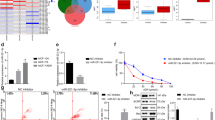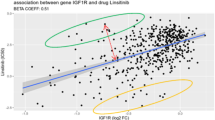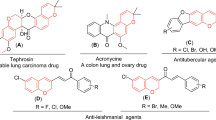Summary
The effects of 4-demethoxydaunorubicin (idarubicin, IDA) and MX2, a new morpholino-anthracycline, on up-regulation of the MDR1 gene in the low-level multidrug resistant (MDR) cell line CEM/A7R were compared at similar concentrations (IC10, IC50and IC90) over a short time exposure (4 and 24 h). The chemosensitivity of each drug was determined by a 3-day cell growth inhibition assay. Compared with epirubicin (EPI), IDA and MX2 were 17- and eightfold more effective in the CEM/A7R line respectively. No cross-resistance to 5-FU was seen in the CEM/A7R line. Verapamil (5 μM) and PSC 833 (1 μM), which dramatically reversed resistance to EPI in the CEM/A7R line, had no sensitizing effect on the resistance of this line to MX2, but slightly decreased resistance to IDA. The sensitivity to 5-FU was unchanged by these modulators. The induction of MDR1 mRNA expression by IDA, MX2 and 5-FU was analysed by Northern blotting and semiquantitatively assessed by scanning Northern blots on a phosphorimager. The relative level of MDR1 expression was expressed as a ratio of MDR1 mRNA to the internal RNA control glyceraldehyde-3-phosphate dehydrogenase (GAPDH). IDA, MX2 and 5-FU differentially up-regulated MDR1 mRNA in the CEM/A7R line in a dose-dependent manner. Both IDA and MX2 induced MDR1 expression within 4 h. 5-FU up-regulated MDR1 expression only when drug exposure was prolonged to 24 h. Based on MRK 16 binding, flow cytometric analysis of P-glycoprotein (Pgp) expression paralleled the increase in MDR1 mRNA levels. For the three anthracyclines, the increase in MDR1 expression was stable in cells grown in the absence of drug for more than 3 weeks after drug treatment. The induction of MDR1 expression by 5-FU was transient, associated with a rapid decrease in the increased Pgp levels which returned to baseline 72 h after the removal of 5-FU. This study demonstrates that MDR1 expression can be induced by analogues of anthracyclies not pumped by Pgp, and that this induction appears to be stable despite a 3-week drug-free period.
Similar content being viewed by others
Article PDF
Change history
16 November 2011
This paper was modified 12 months after initial publication to switch to Creative Commons licence terms, as noted at publication
References
Beketic-Oreskovic, L., Duran, G. E., Chen, G., Dumontet, C. & Sikic, B. I. (1995). Decreased mutation rate for cellular resistance to doxorubicin and suppression of mdr1 gene activation by the cyclosporin PSC 833. J Natl Cancer Inst 87: 1593–1602.
Berman, E. (1993). A review of idarubicin in acute leukemia. Oncology 7: 91–104.
Berman, E. & McBride, M. (1992). Comparative cellular pharmacology of daunorubicin and idarubicin in human multidrug-resistant leukemia cells. Blood 79(1): 3267–3273.
Bosch, I. & Croop, J. (1996). P-glycoprotein multidrug resistance and cancer. Biochim Biophys Acta 1288: F37–F54.
Carella, A. M., Carlier, P., Pungolino, E., Resegotti, L., Liso, V., Stasi, R., Montillo, M., Iacopino, P., Mirto, S., Pagano, L., Leoni, F., Martelli, F. M., Raimondo, F. D., Porcellini, A., de Rui, L., Nosari, A. M., Cimino, R., Damasio, E., Miraglia, E., Fioritoni, G., Ricciuti, F., Carotenuto, M., Longinotti, M., Defazio, D., Fazi, P. & Mandelli, F. (1993). Idarubicin in combination with intermediate-dose cytarabine and Vp-16 in the treatment of refractory or rapidly relapsed patients with acute myeloid leukemia. Leukemia 7: 196–199.
Chaudhary, P. M. & Roninson, I. B. (1993). Induction of multidrug resistance in human cells by transient exposure to different chemotherapeutic drugs. J Natl Cancer Inst 85: 632–639.
Chen, G., Jaffrézou, J. P., Fleming, W. H., Durán, G. E. & Sikie, B. I. (1994). Prevalence of multidrug resistance related to activation of the MDR1 gene in human sarcoma mutants derived by single-step doxorubicin selection. Cancer Res 54: 4980–4987.
Chin, K. V., Chauhan, S. S., Pastan, I. & Gottesman, M. M. (1990). Regulation of mdr RNA levels in response to cytotoxic drugs in rodent cells. Cell Growth Differ 1: 361–365.
Chomczynski, P. & Sacchi, N. (1987). Single-step method of RNA isolation by acid guanidinium thiocyanate–phenol–chloroform extraction. Anal Biochem 162: 156–159.
Consoli, U., Priebe, W., Ling, Y. H., Mahadevia, R., Griffin, M., Zhao, S., Soler, R. P. & Andreeff, M. (1996). The novel anthracycline annamycin is not affected by P-glycoprotein related multidrug resistance: comparison with idarubicin and doxorubicin in HL60 leukemia cell lines. Blood 88: 633–644.
de Vries, E. G. E. & Zijlstra, J. G. (1990). Morpholinyl anthracyclines: option for reversal of anthracycline resistance. Eur J Cancer 26: 659–660.
Deuchars, K. L. & Ling, V. (1989). P-glycoprotein and multidrug resistance in cancer chemotherapy. Semin Oncol 16: 156–165.
Dumontet, C., Duran, G. E., Steger, K. A., Beketic-Oreskovic, L. & Sikic, B. I. (1996). Resistance mechanisms in human sarcoma mutants derived by single-step exposure to paclitaxel (Taxol). Cancer Res 56: 1091–1097.
Fardel, O., Lecureur, V., Daval, S., Corlu, A. & Guillouzo, A. (1997). Up-regulation of P-glycoprotein expression in rat liver cells by acute doxorubicin treatment. Eur J Biochem 246: 186–192.
Ferrandis, E. & Benard, J. (1993). Activation of the human MDR1 gene promoter in differentiated neuroblasts. Int J Cancer 54: 987–991.
Gekeler, V., Beck, J., Noller, A., Wilisch, A., Fresc, G., Neumann, M., Handgretinger, R., Ehninger, G., Probst, H. & Neithammer, D. (1994). Drug-induced changes in the expression of MDR-associated gene: investigations on cultured cell lines and chemotherapeutically treated leukemias. Ann Hematol 69: S19–S24.
Grogan, T. M., Spier, C. M., Salmon, S. E., Matzner, M., Rybski, J., Weinstein, R. S., Scheper, R. J. & Dalton, W. S. (1993). P-glycoprotein expression in human plasma cell myeloma: correlation with prior chemotherapy. Blood 81: 490–495.
Hargave, R. M., Davey, M. W., Davey, R. A. & Kidman, A. D. (1995). Development of drug resistance is reduced with idarubicin relative to other anthracyclines. Anti-Cancer Drugs 6: 432–437.
Horichi, N., Tapiero, H., Sugimoto, Y., Bungo, M., Nishiyama, M., Fourcade, A., Lampidis, T. J., Kasahara, K., Sasaki, Y., Takahashi, T. & Saijo, N. (1990). 3′-Deamino-3′-morpholino-13-deoxo-10-hydroxycarminomycin conquers multidrug resistance by rapid influx following higher frequency of formation of DNA single- and double-strand breaks. Cancer Res 50: 4698–4701.
Hu, X. F., de Luise, M., Martin, T. J. & Zalcberg, J. R. (1990b). Effect of cyclosporin and verapamil on the cellular kinetics of daunorubicin. Eur J Cancer 26: 814–817.
Hu, X. F., Martin, T. J., Bell, D. R., de Luise, M. & Zalcberg, J. R. (1990a). Combined use of cyclosporin A and verapamil in modulating multidrug resistance in human leukemia cell lines. Cancer Res 50: 2953–2957.
Hu, X. F., Slater, S., Wall, D. M., Kantharidis, P., Parkin, J. D., Cowman, A. & Zalcberg, J. R. (1995). Rapid upregulation of mdr1 expression by anthracyclines in a classical multidrug-resistant cell line. Br J Cancer 71: 931–936.
Hu, X. F., Slater, A., Wall, D. M., Parkin, J. D., Kanthrarids, P. & Zalcberg, J. R. (1996). Cyclosporin A and PSC 833 prevent up-regulation of MDR1 expression by anthracyclines in a human multidrug-resistant cell line. Clin Cancer Res 2: 713–720.
Kohno, K., Sato, S., Takano, H., Matsuo, K-I & Kuwano, M. (1989). The direct activation of human multidrug resistance gene (MDR1) by anticancer agents. Biochem Biophys Res Commun 165: 1415–1421.
Manzano, R. G., Wright, V. K. & Twentyman, P. R. (1996). Rapid recovery of a functional MDR phenotype caused by MRP after a transient exposure to MDR drugs in a revertant human lung cancer cell line. Eur J Cancer 32A: 2136–2141.
Michieli, M., Michelutti, A., Damiani, D., Pipan, C., Paspadori, D., Lauria, F. & Baccarani, M. (1993). A comparative analysis of the sensitivity of multidrug resistant (MDR) and non-MDR cells to different anthracycline derivatives. Leukemia Lymphoma 9: 255–264.
Mickenna, S. L. & Padua, R. A. (1997). Review: multidrug resistance in leukemia. Br J Haematol 96: 659–674.
Nielsen, C., Maare, C. & Skovesgaard, T. (1996). Cellular resistance to anthracyclines. Gen Pharmacol 27: 251–255.
Nooter, K. & Sonneveld, P. (1994). Clinical relevance of P-glycoprotein expression in haematological malignancies. Leukemia Res 18: 233–243.
Osborn, M. T. & Chambers, T. C. (1996). Role of the stress-activated/c-jun NH2-terminal protein kinase pathway in cellular response to adriamycin and other chemotherapeutic drugs. J Biol Chem 271: 30950–30955.
Poeta, G. D., Stasi, R., Aronica, G., Venditti, A., Cox, M. C., Bruno, A., Buccisano, F., Masi, M., Tribalto, M., Amadori, S. & Papat, G. (1996). Clinical relevance of P-glycoprotein expression in de novo acute myeloid leukemia. Blood 87: 1997–2004.
Rohlff, C. & Glazer, R. I. (1995). Regulation of multidrug resistance through the c-AMP and EGF signalling pathways. Cell Signalling 7: 431–443.
Ross, D. D., Doyle, L. A., Yang, W., Tong, Y. & Cornblatt, B. (1995). Susceptibility of idarubicin, daunorubicin and their C-13 alcohol metabolites to transport-mediated multidrug resistance. Biochem Pharmacol 50: 1673–1683.
Rothenberg, M., Mickley, L. A., Cole, D. E., Balis, F. M., Tsuruo, T., Poplack, D. & Fojo, A. T. (1989). Expression of the mdr1/P-170 gene in patients with acute lymphoblastic leukemia. Blood 74: 1388–1395.
Shustik, C., Dalton, W. & Gros, P. (1995). P-glycoprotein-mediated multidrug resistance in tumor cells; biochemistry, clinical relevance and modulations. In Molecular Aspects of Medicine pp., 1–78, Elsevier Science: London
Tanimura, H., Kohno, K., Sato, S-i, Uchiumi, T., Miyazaki, M., Kobayashi, M. & Kuwano, M. (1992). The human multidrug resistance 1 promoter has an element that responds to serum starvation. Biochem Biophys Comm 183: 917–924.
Tsuruo, T., Iida, H., Tsukagoshi, S. & Sakurai, Y. (1981). Overcoming of vincristine resistance in P388 leukemia in vivo and in vitro through enhanced cytotoxicity of vincristine and vinblastine by verapamil. Cancer Res 41: 1967–1972.
Ueda, K., Clark, D. P., Chen, C-J, Roninson, I. B., Gottesman, M. M. & Pastan, I. (1987). The human multidrug resistance (mdr1) gene: cDNA cloning and transcription initiation. J Biol Chem 262: 505–508.
Watanabe, M., Komeshima, N., Naito, M., Isoe, T., Otake, N. & Tsuruo, T. (1991). Cellular pharmacology of MX2, a new morpholino anthracycline, in human pleiotropic drug-resistant cells. Cancer Res 51: 157–161.
Zalcberg, J. R., Hu, X. F., Wall, D. M., Mirski, S., Cole, S., Nadalin, G., De Luise, M., Parkin, J. D., Vrazas, V., Campbell, L. & Kantharidis, P. (1994). Cellular and karyotypic characterization of two doxorubicin resistant cell lines isolated from the same parental human leukemia cell line. Int J Cancer 57: 522–528.
Author information
Authors and Affiliations
Rights and permissions
From twelve months after its original publication, this work is licensed under the Creative Commons Attribution-NonCommercial-Share Alike 3.0 Unported License. To view a copy of this license, visit http://creativecommons.org/licenses/by-nc-sa/3.0/
About this article
Cite this article
Hu, X., Slater, A., Rischin, D. et al. Induction of MDR1 gene expression by anthracycline analogues in a human drug resistant leukaemia cell line. Br J Cancer 79, 831–837 (1999). https://doi.org/10.1038/sj.bjc.6990133
Received:
Revised:
Accepted:
Published:
Issue date:
DOI: https://doi.org/10.1038/sj.bjc.6990133



